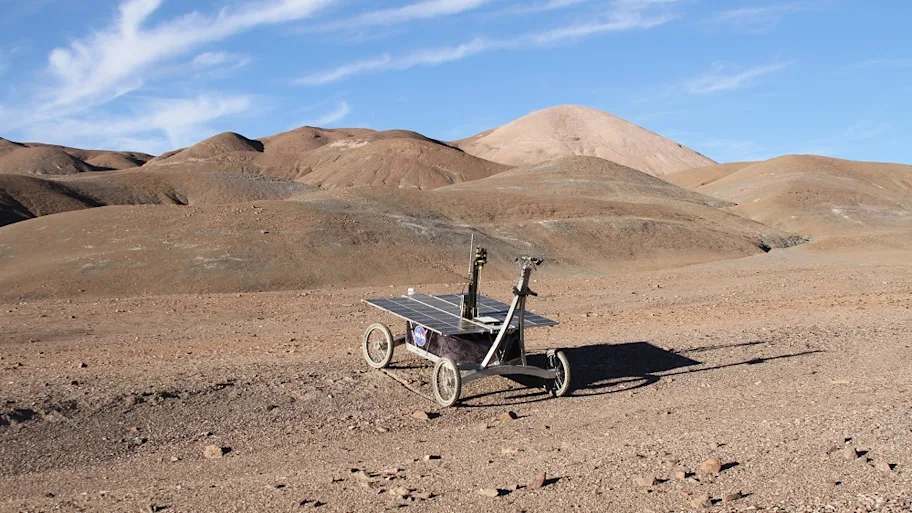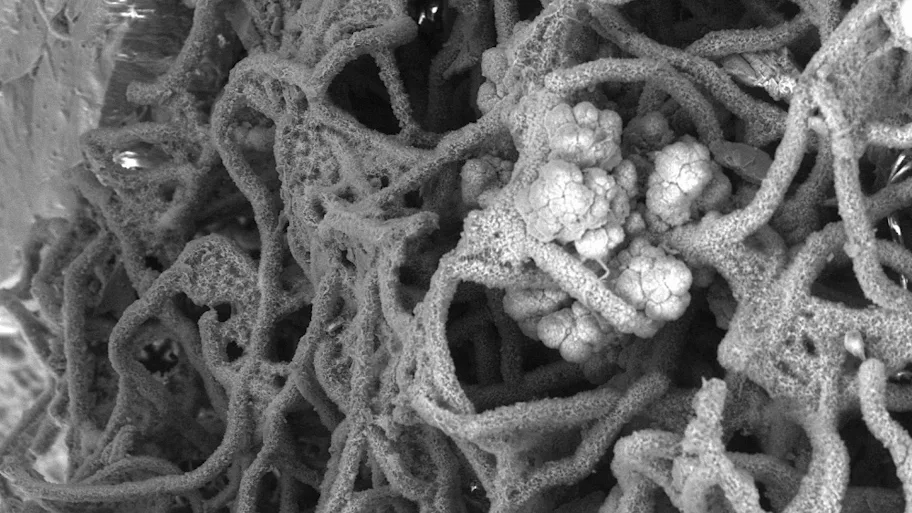
- Science news
- Young Minds
- What Rabbits and Martian Rovers Taught Me About Scale
What Rabbits and Martian Rovers Taught Me About Scale
View of the Atacama Desert of Northern Chile with a geologist for scale (Amanda Baker)
Note: This blog post was originally published as a blog on Scientific American (http://blogs.scientificamerican.com/frontiers-for-young-minds/what-rabbits-and-martian-rovers-taught-me-about-scale/__)
Quite often when I am looking at photos, I just feel like something is missing. It is not a criticism of the light or the composition, but rather that something is, quite literally, missing: a scale.
As someone who completed a PhD in geology, I am probably biased. I have more photos of my rock hammer and my field book than photos of any person I know. So when I find myself frustrated by ambiguous images of landscapes, I just tell myself that my viewpoint has become skewed over thousands of photos of ambiguously sized desert features.
Examples of desert features that are approximately pencil-, field-book-, or field-assistant-sized (Amanda Baker)
But then I see a new photo of a boulder or mountain on Mars, and I get excited. Like this mysterious rock that appeared between two images – I told myself that it must be important if they named it and gave it a press release. Then I looked it up and found out that the rock is “about the size of a doughnut.” It was no less important scientifically, but what I had been originally picturing in my head left me feeling a bit silly.

Appearance of “Pinnacle Island” rock observed by Opportunity rover (Source: NASA/JPL-Caltech/Cornell Univ./Arizona State Univ.)
And when the team from the Martian Rover Curiosity released this panorama, I imagined myself standing on the great Martian landscape like I had in the Atacama.

Mosaic of images from Curiosity rover near Point Lake outcrop (Source:NASA/JPL-Caltech/MSSS)
I imagined that I was looking at something like this. Note that the small dots in the valley are, in fact, three trucks and five tents.
View of Atacama Desert of Northern Chile – Note the tiny trucks and tents in the distance (Amanda Baker)
But when I looked at the image of the Martian landscape a little more closely, I noticed the scale bars. Instead of looking at a landscape like the one above, it was much closer to the scope of the image below. If you notice, the tents are somewhat easier to see.

Punta de Lobos in Atacama Desert – Once again, tents to provide scale (Amanda Baker)
As dramatic as this was, my ultimate surprise was probably the Martian feature of Mount Sharp. I looked at the photo and – having been recently burned by the doughnut-sized rock – I was skeptical. “Really,” I thought to myself, “they want to call that a mountain? It is probably just a glorified hill.”
Mosaic of images showing Mount Sharp (also called Aleolis Mons) from Mars rover Curiosity (Source: NASA/JPL-Caltech/MSSS)
I figured it was something like this – large, but you could walk to the top in under an hour.
Cinder cone near Flagstaff Arizona, with graduate students providing scale (Amanda Baker)
But, no. I looked it up and the relief (from the mountain peak to the crater floor) was about 18,000 feet! If I were to include a picture of a feature of similar scale on Earth, it would look something like this:
(Mount McKinley, Denali National Park and Preserve (Credit: Anconcagua))
The comparable base-to-peak measurement of Mount Everest is about 15,000 feet (its overall altitude above sea level is higher). For Mount McKinley (pictured above) the comparable measure is about 18,000 feet. That made me look back that the image from Mars and – once again – just feel a bit silly as I had to re-adjust.
As someone who spent a lot of time in the desert pretending I was on Mars, I find these examples particularly compelling. But I know that contemplating images of far-off landscapes may not be a common hobby. To consider another example that may be a bit closer to home, scroll down slowly and observe the animal in the next image.
When you look at this you probably think, “Hey … a rabbit!” and that is about it. (Source: Eponimm)
Now, how big do you imagine it is?
Unless you have some level in expertise when it comes to rabbits, you probably thought, “It’s a rabbit. It’s probably a bit smaller than a cat,” or something equivalent.
Now look the next two photos, which also contain rabbits, but also contain some other objects to provide scale.
Child petting a (much smaller) rabbit (Source: Piotrus)

Flemish Giant with a Shetland Sheepdog (Source: Stamatisclan)
Be honest, you probably had to take a moment to think that through. For your reference, the animal in the original photo is a Flemish Giant as well.
Whenever we encounter a landscape or animal or number or anything else that we think we understand, we don’t tend to think about the misconceptions we might have. Maybe someone has told you that a storm is a certain number of miles wide, but if you don’t have a reference point for how big that number is, you might not think about it very deeply. If someone says that same storm is the size of Texas, it might change the way you think about it.
The same could be said for comparing numbers to each other, like in the cartoon below:
Another lesson in appreciating the scale of what you are looking at (Adapted from source: xkcd.com)
Scientists have a great need to be precise when they are observing or measuring the world around them, but taking a moment to put numbers and images into a framework that you can more easily relate to is an important practice for anyone. Even the most well-trained minds can’t help getting caught up without a reference point.
While you could use this as a way to trick your parents into getting a Flemish Giant when they said that the family can only get a rabbit instead of a dog (please don’t do this), it is also an important mindset for interacting with the images and information that you come in contact with every day.
Sources:
http://en.wikipedia.org/wiki/Aeolis_Mons
Images:
http://photojournal.jpl.nasa.gov/catalog/PIA17761
http://photojournal.jpl.nasa.gov/catalog/PIA17595
http://photojournal.jpl.nasa.gov/catalog/PIA16768
http://commons.wikimedia.org/wiki/File:Denali_04.jpg
http://commons.wikimedia.org/wiki/File:Geant_des_flandres_101.JPG
http://commons.wikimedia.org/wiki/File:Hampyeong_butterfly_festival_111.JPG
http://commons.wikimedia.org/wiki/File:Runt_and_Paxie.jpg
http://xkcd.com/558/ – Adapted to include only part of full cartoon.
*Note: Comic from xkcd.com was cropped from an earlier version of this post to be more suitable for a younger audience.
Amanda Baker is a Program Manager at Frontiers and Project Manager for Frontiers for Young Minds.






